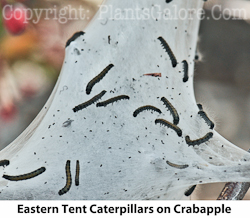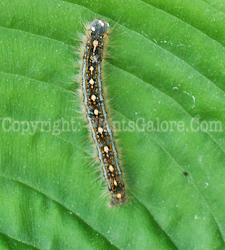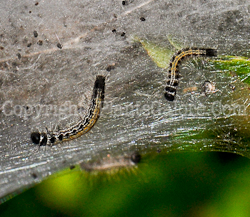|
 |
|
 |
|
 |
 |
 These
are the common tent forming
caterpillars that show up
early in the spring. They are different from the fall
webworms which, as the name implies, make their nests
late in the summer into the autumn. These
are the common tent forming
caterpillars that show up
early in the spring. They are different from the fall
webworms which, as the name implies, make their nests
late in the summer into the autumn.
|
 |
|
 |
 |
 Eastern tent
caterpillars form their nests in the crotch of tree
branches. They are perhaps most common on crabapple
trees although they may be found on other species
too such as hawthorn, maple, cherry, peach, pear and
plum. Eastern tent
caterpillars form their nests in the crotch of tree
branches. They are perhaps most common on crabapple
trees although they may be found on other species
too such as hawthorn, maple, cherry, peach, pear and
plum. The adult lays
eggs on the bark of the tree in the fall. In the
spring as the leaves are opening from the buds, the
eggs hatch and the caterpillars do too. As they
feed, the spin a web nest that expands as the season
progresses. In about mid-summer, the 2 to 2 1/2 inch
long caterpillars form cocoons and in about 3 weeks
a small, brownish moth emerges.
Generally speaking, these critters are more of an
aesthetic problem in the home landscape. Sure they
eat some leaves but, unless there are many nests in
a small tree, not enough to seriously hurt the tree.
The large, silky nests, however, are an eyesore on a
nice crabapple in the yard.
|
 |
 |
 |
There are a couple of
approaches to prevent Eastern tent caterpillars from
making a mess in your trees:
1.
Remove Egg Masses - As
mentioned above, the adults lay their eggs on the
bark of trees in the fall. If you look closely near
the crotch of susceptible species of trees, you may
be able to see the egg masses. Scrape them off
(without damaging the bark, of course) into a pail
of soapy water.
 2.
Catch Them Early - The
eggs will hatch at the same time as the leaves
appear on the tree. Nature has worked it out so that
the hungry little creatures stir into life just in
time to have a meal. So, when you see the leaves,
take a close look in the crotches between main
branches and the trunk of the tree. Within a week or
two of leaf emergence, you should begin to see tiny
webbed nests starting to be formed. At night or in
the heat of mid-day, carefully remove the nest and
put it in a pail of soapy water. The caterpillars
tend to be out eating in early morning and evening
and are usually in the nest during the heat of the
day or on rainy days. 2.
Catch Them Early - The
eggs will hatch at the same time as the leaves
appear on the tree. Nature has worked it out so that
the hungry little creatures stir into life just in
time to have a meal. So, when you see the leaves,
take a close look in the crotches between main
branches and the trunk of the tree. Within a week or
two of leaf emergence, you should begin to see tiny
webbed nests starting to be formed. At night or in
the heat of mid-day, carefully remove the nest and
put it in a pail of soapy water. The caterpillars
tend to be out eating in early morning and evening
and are usually in the nest during the heat of the
day or on rainy days.
There is only one
generation per year so, if you do this once, it
should take care of the problem until the following
spring.
|
 |
 |
 |
If you did not catch the
problem (see Problem Prevention above), you can still
control damage from the Eastern tent caterpillar. In
fact, this is the situation for most people who don't
notice them until the nest is quite large and the
caterpillars are already near the end of their 4 to 6
week feeding cycle. First
and foremost, DO NOT BURN THE NEST!!! Sure that will get
rid of the caterpillars and may make you feel
better...however, it will also do far more damage to the
tree than the caterpillars.
Again, you can tear down the nest at the times when the
caterpillars are inside or you can treat the nest and
tree with an insecticide that is labeled for Eastern
tent caterpillar.
|
|
 |
|
Note: We
have provided some general information and
observations on this topic aimed at the home
gardener. Before you take
any serious action in your landscape, check
with your state's land grant university's
Cooperative
Extension
Service for the most current,
appropriate, localized recommendations. |
|
 |
|



